Publications
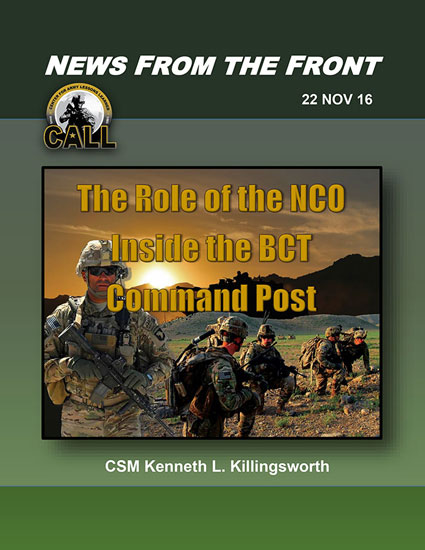 NFTF - The Role of the NCO Inside the BCT Command Post
NFTF - The Role of the NCO Inside the BCT Command Post
An NCO's role in a command post is truly no different than his or her role at the tactical level. NCO's organize Soldiers for the mission by creating a battle roster that reflects the Soldiers and equipment assigned. NCO's identify the training that needs to be conducted in each of the categories of a command post and create teams responsible for specific tasks that support the overall collective tasks of establishing the command post. NCO's create processes that support efficiency, both in the establishment and during operations of the command post, and then we rehearse those processes until they become as familiar as a battle drill. This is an NCO's role in a command post, the same role we have executed since the days of the blue book and the same duties and responsibilities we executed in those all too familiar company teams. It is our job to master those fundamentals of command post operations in order to bring the brigade combat team closer to mastering the fundamentals of combined arms maneuver.
The Doctrine Smart Book is a concise collection of Army doctrine summaries that reflects current approved doctrine and is prepared by the Combined Arms Center at Fort Leavenworth, Kansas. The first half of the Doctrine Smart Book provides a visual representation of the Army’s doctrinal hierarchy and its corresponding joint doctrine. It illustrates the hierarchy of Army doctrine publications (ADPs) and Army doctrine reference publications (ADRPs). It then illustrates the hierarchy as it applies to the Army’s field manuals (FMs). The remaining hierarchy details publications—including FMs and Army techniques publications (ATPs)—by decisive action, types of operations, warfighting functions, and centers of excellence. The second half of the Doctrine Smart Book consists of one-page synopses of each current approved ADP, ADRP, and FM. The first five publications listed are those approved by the Chief of Staff of the Army. Each synopsis contains the characteristics, fundamentals, terms, and ideas as they are discussed in each publication. The principal audience for the Doctrine Smart Book is all readers of doctrine—military, civilian, and contractor.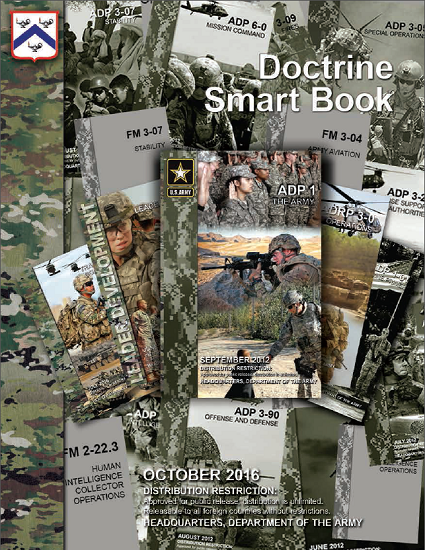 Doctrine Smart Book, OCT 16
Doctrine Smart Book, OCT 16
ADP 3-0 is one of the Army’s two capstone doctrine publications; the other is ADP 1, The Army. ADP 3-0 presents overarching doctrinal guidance and direction for conducting operations. It constitutes the Army’s view of how it conducts prompt and sustained operations on land and sets the foundation for developing the other principles, tactics, techniques, and procedures detailed in subordinate doctrine publications. ADP 3-0 provides operational guidance for commanders and trainers at all echelons and forms the basis for Army education system curricula. (See figure 1 on page iv for a chart of the logic of ADP 3-0.) The principal audience for ADP 3-0 is Army officers in the rank of major and above who command Army forces in major operations and campaigns or serve on the staffs that support those commanders. It is also applicable to the civilian leaders of the Army. ADP 3-0 uses joint terms where applicable. Most terms with joint or Army definitions are in both the glossary and the text. ADP 3-0 is not the proponent publication (the authority) for any Army term. ADRP 3-0 is now the proponent publication for terms which the previous ADP 3-0 was the authority. For definitions in the text, the term is italicized and the number of the proponent publication follows the definition. Commanders, staffs, and subordinates ensure their decisions and actions comply with applicable United States, international, and, in some cases, host-nation laws and regulations. Commanders at all levels ensure their Soldiers operate in accordance with the law of war and the rules of engagement. (See FM 27-10.)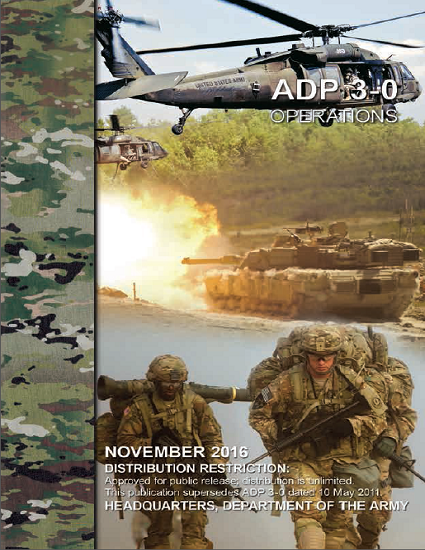 ADP 3-0 Operations, 11 NOV 16
ADP 3-0 Operations, 11 NOV 16
ADRP 3-0 augments the land operations doctrine established in ADP 3-0, Operations. This publication expands the discussion of the overarching guidance on unified land operations. It accounts for the uncertain and ever-changing nature of operations and recognizes that a military operation is foremost a human undertaking. It constitutes the Army’s view of how to conduct prompt and sustained operations on land and sets the foundation for developing the other principles, tactics, techniques, and procedures detailed in subordinate doctrine publications. Combined with ADP 3-0, the doctrine in ADRP 3-0 provides the foundation for the Army’s operational concept of unified land operations. This publication also forms the foundation for training and Army education system curricula on unified land operations. The principal audience for ADRP 3-0 is all members of the Profession of Arms. Commanders and staffs of Army headquarters serving as joint task force or multinational headquarters should also refer to applicable joint or multinational doctrine concerning the range of military operations and joint or multinational forces. Trainers and educators throughout the Army will also use this publication.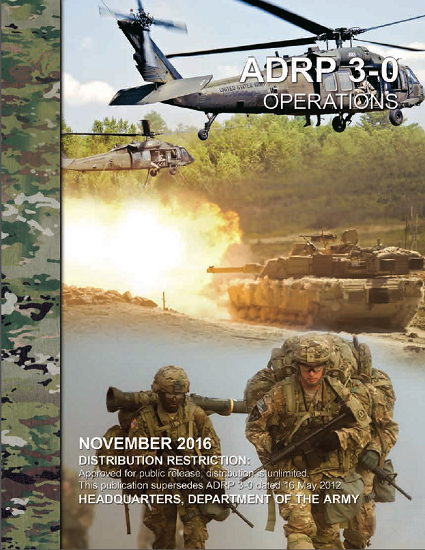 ADRP 3-0 Operations, 11 NOV 16
ADRP 3-0 Operations, 11 NOV 16
 NFTF - Tomahawks Take on NTC: Strykers in a Complex Fight
NFTF - Tomahawks Take on NTC: Strykers in a Complex Fight
In August of 2015, 4th Battalion, 23rd Infantry Regiment, Second Brigade Combat Team, (4-23 IN) "Tomahawks" began preparations to deploy to the National Training Center (NTC) at FT Irwin, CA rotation 16-03. While at the NTC, the Tomahawks achieved success during urban operations in two of the population centers, Ujen and Razish. The battalion was able to secure both objectives, suffering minimal casualties throughout the operation. This paper documents some proven methods used to train Soldiers for NTC and how to fight Strykers in urban terrain. The discussion centers around the battalion's training, planning preparation and execution for urban objectives, and the lessons learned from fighting in urban environments from a Stryker platform.
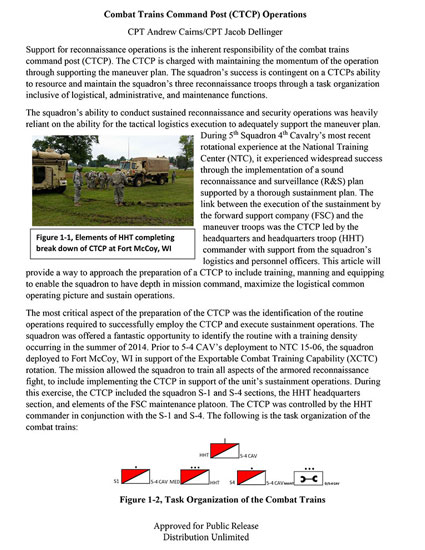 NFTF: Combat Trains Command Post (CTCP) Operations
NFTF: Combat Trains Command Post (CTCP) Operations
Support for reconnaissance operations is the inherent responsibility of the combat trains command post (CTCP). The CTCP is charged with maintaining the momentum of the operation through supporting the maneuver plan. The squadron’s success is contingent on a CTCPs ability to resource and maintain the squadron’s three reconnaissance troops through a task organization inclusive of logistical, administrative, and maintenance functions.
This News From the Front (NFTF) shares the story of U.S. Army Africa (USARAF) and highlights some of the creative ways it accomplishes its security cooperation goals on the continent. To that end, this NFTF addresses: 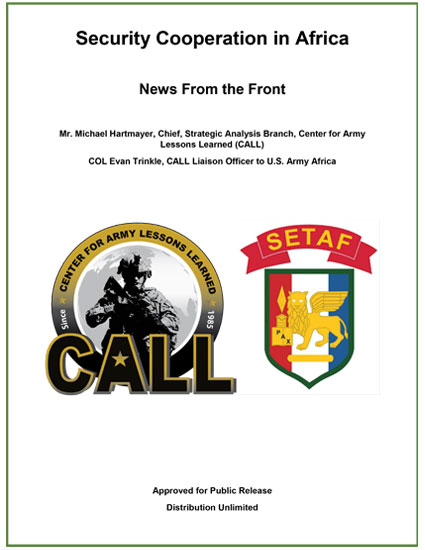 News From the Front: Security Cooperation in Africa
News From the Front: Security Cooperation in Africa
• Key USARAF insights on security cooperation in Africa.
• The African Land Forces Summit (ALFS).
• An interview with the USARAF Commanding General.
When it comes to providing comfortable living spaces for deployed Soldiers, rigid-wall shelters are a very particle solution when building the force base camp. Each rigid-wall shelter can house 10 Soldiers and be set up in less than 15 minutes by four people. Once they are up and running, the camps require little maintenance.
The Rapid Equipping Force provided rigid wall shelters to the Force Provider Camp – Erbil. This News From The Front covers the Lessons Learned while constructing the camp.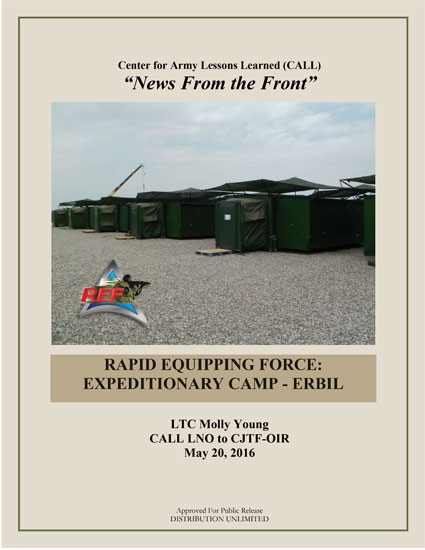 News From The Front: Rapid Equipping Force Expeditionary Camp - ERBIL
News From The Front: Rapid Equipping Force Expeditionary Camp - ERBIL
FM 7-0, Train to Win in a Complex World, describes how the Army trains to win. With that focus, the Army develops training readiness and the capabilities that support Army and joint force commanders. FM 7-0 applies to all leaders at all organizational levels. All leaders are trainers. Leaders include officers, warrant officers, noncommissioned officers, and Department of the Army Civilians in leadership positions. The principal audience for FM 7-0 is all members of the Profession of Arms, leaders, Soldiers, Army Civilians, and contractors who might be isolated from others during a mission. Trainers and educators throughout the Army will also use this publication. Commanders, staffs, and subordinates ensure their decisions and actions comply with applicable United States, international, and in some cases, host-nation laws and regulations. Commanders at all levels ensure their Soldiers operate in accordance with the law of war and the rules of engagement (see FM 27-10).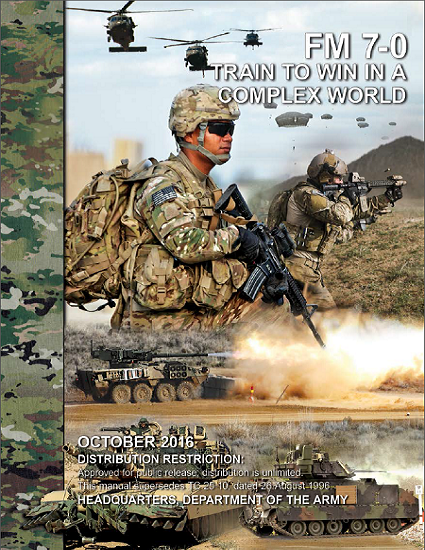 FM 7-0 Train to Win in a Complex World, 5 OCT 16
FM 7-0 Train to Win in a Complex World, 5 OCT 16
 Newsletter 16-30: DATE at the NTC Vol. IV
Newsletter 16-30: DATE at the NTC Vol. IV
This volume is the fourth installment of the NTC decisive action series published by the Center for Army Lessons Learned. It represents our commitment to the ongoing professional discussion of how the Army, as the component responsible for imposing the will of the Nation upon our enemies, achieves decisive action by means of our core competencies.
 16-27: Pacific Pathways Lessons and Best Practices Newsletter
16-27: Pacific Pathways Lessons and Best Practices Newsletter
This newsletter is the final document of a series consisting of three initial impression reports (IIRs) documenting Pacific Pathways 15.
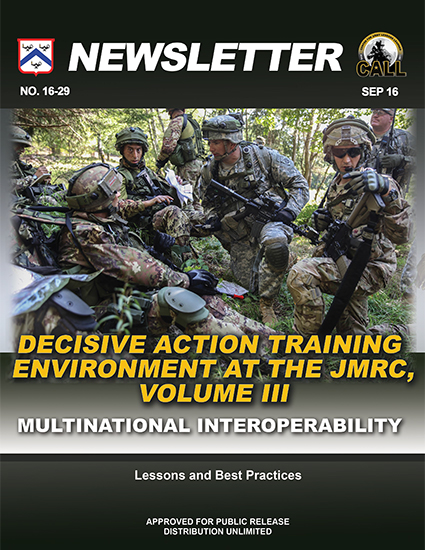 16-29 - DATE at the JMRC Vol. III: Multinational Interoperability Newsletter
16-29 - DATE at the JMRC Vol. III: Multinational Interoperability Newsletter
The tactical lessons in multinational interoperability contained in this newsletter are not unique to the NATO alliance but are, however, transcendent to any situation in which a military coalition of nations must form, build a cohesive team, and operate seamlessly against a common enemy at the tactical level of warfare. This newsletter's collection of articles is intended to supplement and reinforce those lessons described in our publication of the Multinational Interoperability Reference Guide (CALL Handbook 16-18). Thus, the goal is to provide tactical-level insights and lessons gleaned from numerous multinational exercises that military leaders can use to logically approach the complexities of interoperability in multinational environments.

